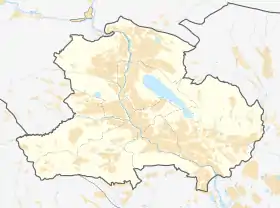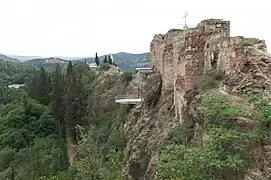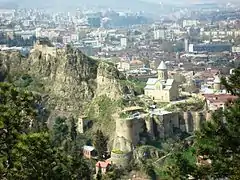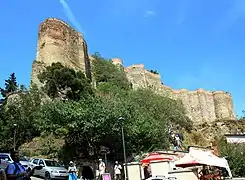Narikala
Narikala (Georgian: ნარიყალა) is an ancient fortress overlooking Tbilisi, the capital of Georgia, and the Mtkvari (Kura) River. The fortress consists of two walled sections on a steep hill between the sulfur baths and the botanical gardens of Tbilisi. On the lower court there is the recently restored St Nicholas church. Newly built in 1996–1997, it replaces the original 13th-century church that was destroyed in a fire. The new church is of "prescribed cross" type, having doors on three sides.[1] The internal part of the church is decorated with the frescos showing scenes from both the Bible and the history of Georgia.[2]
| Narikala | |
|---|---|
ნარიყალა | |
| Tbilisi in Georgia | |
 Narikala, with parts of Old Town seen below | |
 Narikala  Narikala | |
| Coordinates | 41°41′16″N 44°48′31″E |
| Type | Fortress |
| Site information | |
| Open to the public | Open |
| Condition | Ruined |
| Site history | |
| Built | 4th Century |
| Materials | Stones and Brick |
| Airfield information | |
| Elevation | 383 metres (1,257 ft) AMSL |
| Official name | Narikala |
| Designated | October 1, 2007 |
| Reference no. | 4696 |
| Item Number in Cultural Heritage Portal | 3616 |
| Date of entry in the registry | October 11, 2007 |
| Accounting Card / Passport # | 010506503 |
History
According to the legend it was built by the king Vakhtang I Gorgasali of ancient Kingdom of Iberia.
Archaeological studies of the region have however revealed that the territory of Tbilisi was settled by humans as early as the 4th millennium BC. The earliest written accounts of settlement of the location come from the second half of the 4th century AD, when a fortress was built during King Varaz-Bakur's reign (ca. 364).[3] Towards the end of the 4th century the fortress fell into the hands of the Persians, but was recaptured by the kings of Kartli by the middle of the 5th century. [4][5] It was considerably expanded by the Umayyads in the 7th century and by king David the Builder (1089–1125), respectively. The Mongols renamed it the "Narin Qala" (i.e., "Little Fortress"). Most of extant fortifications date from the 16th and 17th centuries. In 1827, parts of the fortress were damaged by an earthquake, and were subsequently demolished.
Gallery


 View from the center of Tbilisi.
View from the center of Tbilisi. Wall at the rear part of the fortress.
Wall at the rear part of the fortress.


 View by night.
View by night. St Nicholas church.
St Nicholas church. Interior of St Nicholas church.
Interior of St Nicholas church.
References
- About Sights – Narikala Fortress
- Narikala Fortress in Tbilisi
- Syvänne, Ilkka (30 March 2014). Military History of Late Rome 361–395. ISBN 9781473872240.
- "Კალა - ქართლის ცხოვრების ტოპოარქეოლოგიური ლექსიკონი".
- "Varaz-Bakur". The Oxford Dictionary of Late Antiquity. Oxford University Press. 22 March 2018. ISBN 978-0-19-866277-8.